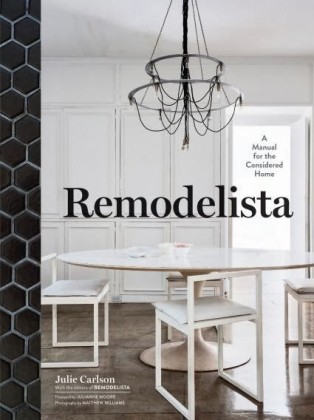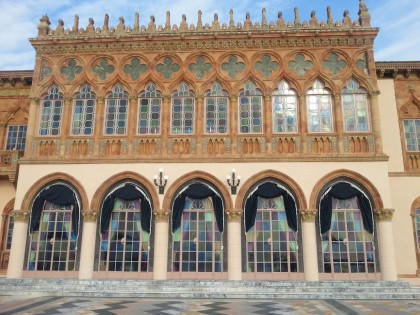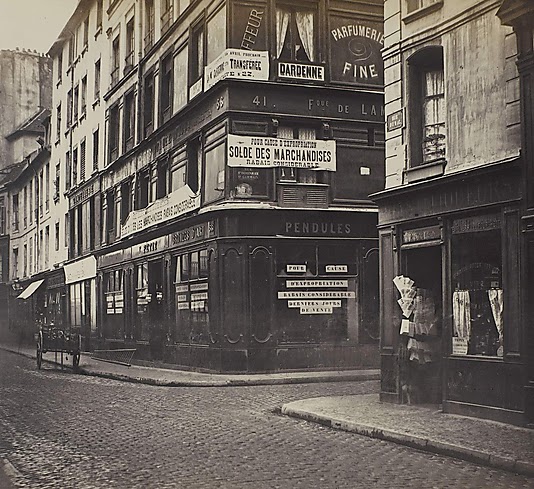 |
| Charles Marville (1813-1879), Corner of rue de Bac and rue Saint-Dominique, Paris, ca. 1874. Photograph Musée Carnavalet, Paris. |
I’m back from my beautiful trip to Paris, where I found spring(!) and about which I’ll be writing for the near future, no doubt. Before I left, I went to see a very interesting exhibition at the Metropolitan Museum, Charles Marville: Photographer of Paris. Commissioned by the city to photograph both pre- and post-Haussmann renovated Paris, Marville’s images are a tremendous documentation of this once medieval city transformed into one of the most grand in Europe. This installation of roughly one hundred images is fantastic and well worth a visit. While you’re there, make sure to take a look at Paris as Muse: Photography, 1840s-1930s in the adjacent Howard Gilman Gallery in the museum.
Charles Marville: Photographer of Paris and Paris as Muse: Photography, 1840s-1930s both run through May 4.
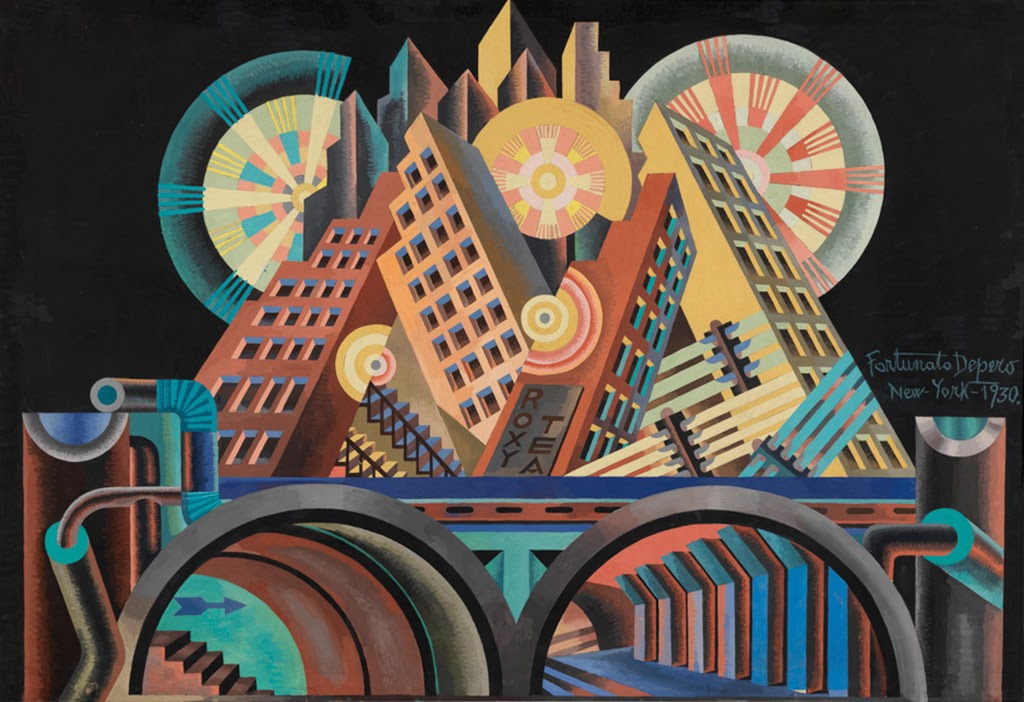 |
| Fortunato Depero, Skyscrapers and Tunnels (Gratticieli e tunnel), 1930. MART, Museo di arte moderna e contemporanea di Trento e Rovereto, Italy © 2014 Artists Rights Society (ARS), New York/SIAE, Rome. Photo: © MART, Archivio Fotografico |
What looks to be an amazing exhibition is opening today at the Guggenheim Museum. Italian Futurism, 1909-1944: Reconstructing the Universe is a major multidisciplinary installation including fine art, film, fashion, design, performance, architecture and the written word (to name a handful) from this tremendously influential, avant-garde movement that essentially revered the new — technology, speed, industry, youth, urbanism. The first show devoted to Italian futurism in the United States, it includes more than 300 works organized chronologically over its 35 year period, and is poised to be one of the standout exhibitions of the year. I know where I’ll be this weekend.
Italian Futurism, 1909-1944: Reconstructing the Universe runs through September 1 at the Solomon R. Guggenheim Museum
www.guggenheim.org
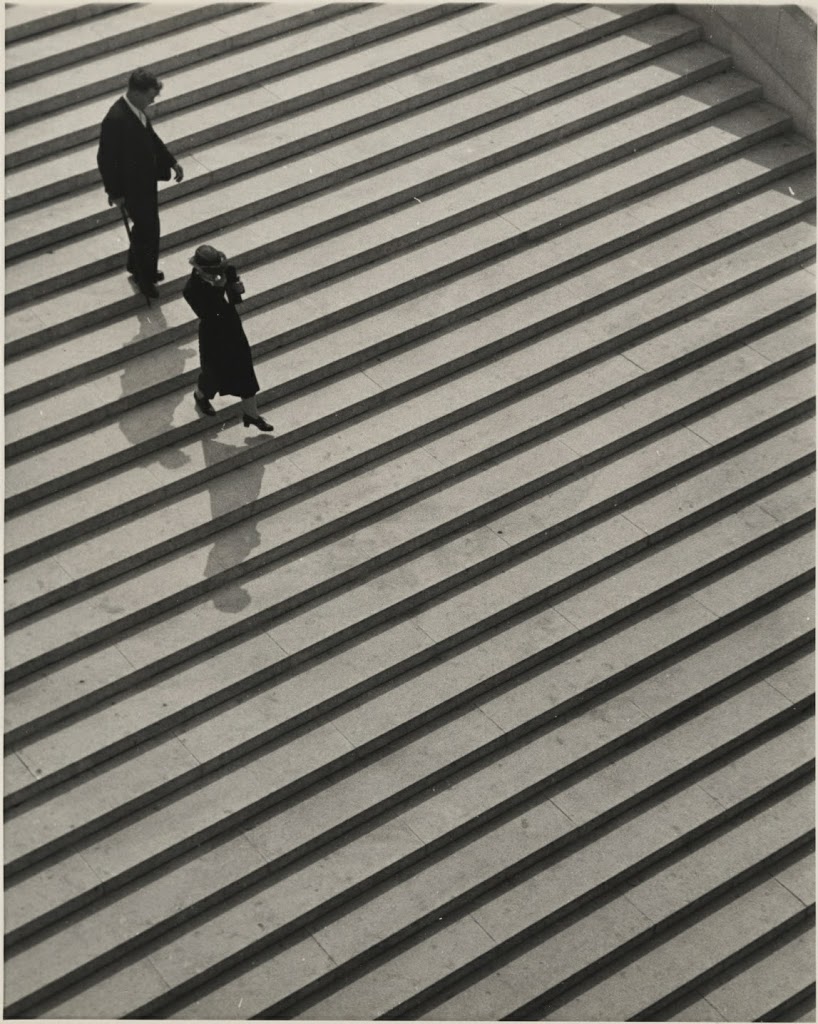 |
People walking down stairs, Exposition Internationale des Arts et Techniques dans la Vie Moderne, 1937.
Photograph F. S. Lincoln.
Fay S. Lincoln Photograph collection, 1920-1968, HCLA 1628, Special Collections Library, Pennsylvania State University. |
As I was writing our recent post on Maynard L. Parker, I couldn’t help but think about F.S. Lincoln (1894-1976), another great American architectural photographer of the same era. Based in Manhattan, Lincoln extensively documented the work of some of the most notable New York architects and designers of the time including McKim, Mead & White, Eugene Schoen, Ely Jacques Kahn, Joseph Aronson and Russel Wright, among numerous others. His work appeared in a wide range of shelter magazines such as Architectural Forum, Architectural Record and House & Garden. He also captured the two New York World’s Fairs and many of the international expositions in Europe, and received large commissions to photograph Colonial Williamsburg and antebellum architecture in the deep south. My favorite F. S. Lincoln photographs are always very distinct, very orderly black and white images of the some of the finest American and European modern design, architecture and interiors.

I recently came across a most fantastic book — Maynard L. Parker: Modern Photography and the American Dream. Published in 2012 by Yale University Press, it is a beauty. I must admit, I had never heard of Maynard L. Parker (1900-1976), one of this country’s most prolific and I would also say influential commercial architectural and design photographers of the twentieth century. From the 1930s through the 1960s, Los Angeles-based Parker’s carefully constructed images of a new modern American aesthetic and way of life, captured mainly in Southern California, filled the pages of numerous leading shelter magazines such as Architectural Digest, Architectural Forum, Sunset and Good Housekeeping. But it was with House Beautiful and its legendary editor-in-chief, Elizabeth Gordon, that Parker enjoyed his most successful and important partnership. In addition, Parker documented the homes of a number of Hollywood celebrities, and the work of a number of celebrated architects, among them Frank Lloyd Wright, Harwell Hamilton Harris and Pierre Koenig. Maynard L. Parker Modern Photography became an enormously successful business and Parker himself, working full-time since the age of 16, did without a doubt, embody the American dream. Although the coffee table cut of this volume could be misleading, it contains seven great, scholarly essays about the life, career and legacy of Maynard L. Parker. I found it seriously enlightening and quite a visual feast. And right now, in the dead of winter, those coastal and poolside photographs of sunny Southern California especially spoke to me!
Maynard L. Parker: Modern Photography and the American Dream, edited by Jennifer Watts (Yale University Press in association with the Huntington Library, 2012)
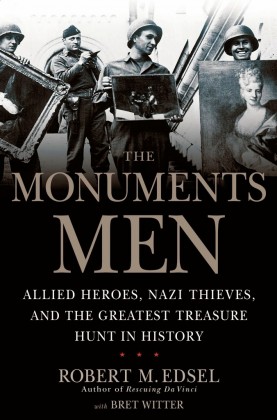
I just finished reading The Monuments Men by Robert M. Edsel, in anticipation of the soon-to-be-released film of the same name. It is the story of the allied force of quite notable art professionals including museum curators and directors, conservators, architects, artists and art historians that volunteered to risk their lives to protect, save and recover Europe’s most important buildings and landmarks and stolen works of art, cultural objects and personal property during and immediately following World War II. It is completely fascinating. The Rape of Europa, both the book by Lynn H. Nicholas and the subsequent documentary, is a brilliant telling of this most tragic moment in history and one whose aftermath still exists to this day. Edsel, actually a co-producer on the documentary, later focused his own tremendous research specifically on those men in the Monuments, Fine Arts and Archives unit (MFAA) and their remarkable and heroic efforts to preserve the artistic heritage of Europe. I can’t wait to see the film and I can’t wait to read Edsel’s new book, Saving Italy: The Race to Rescue a Nation’s Treasures from the Nazis, published last spring.
The Monuments Men by Robert M. Edsel with Bret Witter (Center Street, 2009)
www.monumentsmen.com
One of our favorite daily reads is Remodelista, a fantastic blog that features the very best and most inspired design content on an international scale. It also has some pretty great city guides as well. Remodelista’s gorgeous new book, Remodelista: A Manual for the Considered Home, was published just last month. Well edited, beautifully photographed, relevant and accessible. WE LOVE IT. Design books don’t get much better than this.
Remodelista: A Manual for the Considered Home by Julie Carlson (Artisan, 2013)
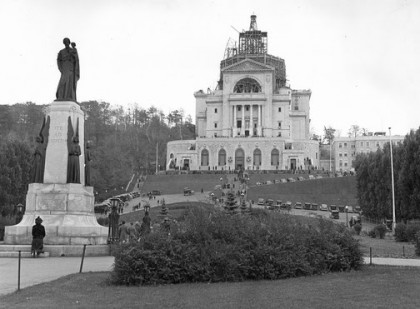 |
Saint Joseph’s Oratory, Mount Royal, Montreal, 1937
Beginning of the construction of the dome.
© Saint Joseph’s Oratory of Mount-Royal (115-56), © Héritage Montréal |
Standing at the highest point in Montreal on lovely Mount Royal, Saint Joseph’s Oratory was built over the course of 42 years on a wonderful property with some of the most breathtaking views of the city. The exterior is designed in the classic Beaux-Arts style, its dome being the third largest in the world. The interior, completed in 1966, is decidedly and wonderfully modern.
Saint Brother André, a native Québecois, started a chapel in honor of Saint Joseph in 1904. Having outgrown the space, plans for a larger church were put in place in 1916 and construction of the basilica began in 1924. Masses of followers made pilgrimages to Montreal to see Brother André during his lifetime as he was known to perform miracles. I have long felt a connection to this place because my grandmother was one of those followers in the 1930s who firmly believed she herself was healed by Brother André.
www.saint-joseph.org/en
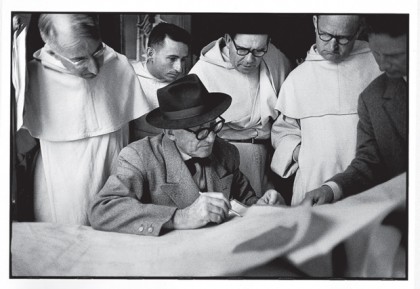 |
Le Corbusier at work on Sainte Marie de la Tourette, Eveux-Sur-Arbresle, 1959
Photograph by René Burri |
Over the weekend I attended the preview of Le Corbusier: An Atlas of Modern Landscapes at MoMA. As promised, this is a seriously comprehensive exhibition beginning with his early life and work in Switzerland and culminating with the last projects before his death in 1965 on the beach near his beloved cottage in Roquebrune-Cap-Martin on the French Riviera. I am a huge fan and it was a dream to see all of this work — including sketches, paintings, architectural models, plans and elevations and so on — organized chronologically in one space to get an even better sense of the evolution and process of one of the most important architects and designers of the twentieth century. Most intriguing for me were actually Le Corbusier’s many paintings, so evocative of the modern movement in the 1920s and 30s, and also his religious buildings. The latter because I didn’t know that aspect of his work as well and because I have always been fascinated with modernist-designed places of worship. These structures number three in total — Chapelle Notre Dame du Haut, Sainte Marie de la Tourette and Sainte Pierre de Firminy — all built in France. The last of which, Saint Pierre de Firminy, was just completed in 2006, more than 40 years after it was conceived. The church of Saint Pierre was finished under the direction of José Oubrerie, an architect who worked for Le Corbusier from 1957 to 1965, and who in fact helped in the design of the edifice from its very beginning during those years. Quite remarkable.
www.moma.org
Before our minds drift completely back to New York from our lovely trip to warm and sunny Sarasota, Florida, we wanted to say a few words about the very special John and Mable Ringling Museum of Art. This wonderful waterfront estate was purchased in 1911 by John Ringling, a member of the Ringling family of circus fame and fortune, and his wife Mable. In 1924, they began construction on Ca’ d’Zan, the Venetian Gothic mansion inspired by their travels to Italy, that was to be their winter home. The most magnificent part of the house is the back where Sarasota Bay stands in for the Grand Canal — truly spectacular. Completed at the end of 1925 and considered to be the last Gilded Age mansion built in the United States, they only enjoyed Ca’ d’Zan together for a few short short years due to Mable’s untimely death in 1929. Incidentally, it was at Ca’ d’Zan that the 1998 movie Great Expectations with Ethan Hawke and Gwenyth Paltrow was filmed.
Today, the property includes two Circus Museums, the Museum of Art that houses the Ringling’s world-renowned collection of Old Masters as well as special exhibitions; the Historic Asolo Theater, an 18th-century palace playhouse from Asolo, Italy that was dismantled in the 1940s, brought to the estate and lovingly reconstructed over the course of several years; numerous gardens and the glorius Millenium Tree Trail. All of which is not to be missed.
as interviewed by Angie Nevarez, co-author of THE BATON:
YOU ARE AN AUTHOR, WRITER, RESEARCHER, MOTHER, SISTER, DAUGHTER, ALUMNA, DEDICATED COMMUNITY MEMBER AND SEEKER OF THINGS THAT DELIGHT — HOW DO YOU INTRODUCE YOURSELF?
I love to introduce myself as Ella and Grace’s mother — it’s my favorite position in life and the one I find most inspiring.
HOW HAS YOUR FIRST MAJOR PUBLICATION, THE INVENTION OF CHIC: THÉRÈSE BONNEY AND PARIS MODERNE, INFLUENCED YOUR LIFE AND WORK?
In the most tangible sense, I discovered new subject matter while I was researching and writing this book. It pretty much set my course for the next several years and very much continues to do so. In a less tangible but certainly more profound sense, I met a lot of fascinating and generous people here and in Europe during the preparation of The Invention of Chic — many of whom I remain close friends with. I am still in awe of all of the doors that were opened to me during that process and all of the information very willingly exchanged. This generous and open spirit has definitely influenced my professional life resulting in a number of great collaborations and connections with other scholars and writers.
WHAT PROJECTS ARE YOU WORKING ON NOW?
Two books, two articles and this blog!
WHAT BRINGS YOU JOY?
My family first and foremost. And second, travel — with my family, of course.
COMB OR BRUSH?
A large wooden paddle brush — it’s the only thing that can get through this head of hair.
DO YOU LIKE YOUR NAME?
I do, although its a bit of a mouthful — Lisa Pilar Schlansker Kolosek. I especially enjoyed growing up with the middle name Pilar — its so beautiful and strong and I was named after a family friend in Spain which I find quite endearing. In fact, I think it’s such a good name that I passed it on to my daughter Grace as her middle name. She really likes it too.
FINISH THIS SENTENCE: MY AGE IS…………….
something I hope makes me more interesting and something I know makes me more confident. I don’t worry about the small things like I used to and I know myself so much better now which is really quite liberating.
WHAT’S FOR DINNER TONIGHT?
Lovely organic blueberry pancakes. Its been a crazy day……….






